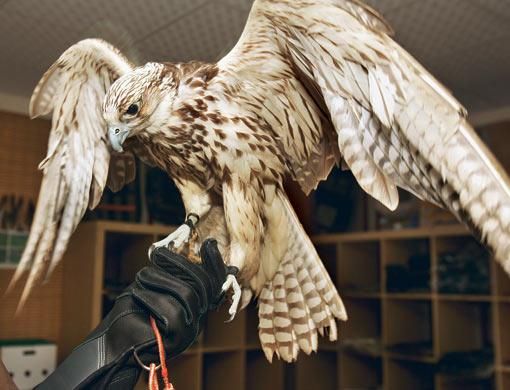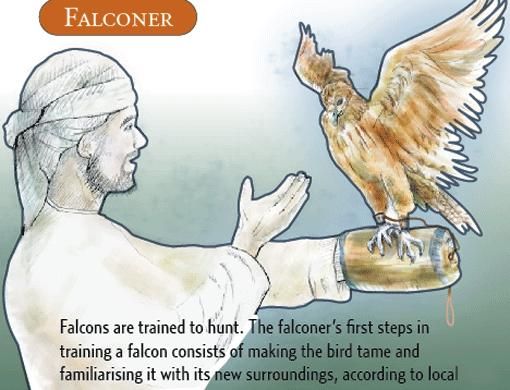The Encyclopaedia Britannica classifies the falcon as a member of the hawk family and a bird of prey. The sport of falconry, popular in some parts of the world, involves training falcons to hunt other birds.
Falcons range in size from 15 to 61 centimetres and the female is usually larger than the male.
These majestic birds — in all shapes, sizes and colours — were brought together at the two-day Falconry Festival recently held in Berkshire, United Kingdom, to raise awareness about the issues threatening falconry.
Falcons from more than 30 countries participated in the festival, which was organised by the Emirates Falconers Club and International Wildlife Consultants.
Falcons from the UAE have passports issued to them — something unheard of for their counterparts in the rest of the world who need permits to travel outside their home countries.
The Falcon Passport, as it is called, was launched in the UAE to combat the illegal trade in falcons within the region. The passport documents the bird's country of origin, permit number and the date of its last export or import. So far, more than 790 passports have been issued.
The passport also lets the falcons travel abroad without the need for a permit from the Convention of International Trade in Endangered Species of Wild Fauna and Flora (CITES).
The Falcon Passports initially started in 2002 and are issued in Abu Dhabi, Dubai and the Northern Emirates.
The falcon registration forms are available at the Abu Dhabi Falcon Hospital, which is the only hospital authorised to issue Falcon Passports. In Dubai and the Northern Emirates, the passports are issued by the Ministry of Agriculture and Fisheries.
These passports have to be renewed every three years when the falcons' registration is renewed to maintain the bird's legal status.
Majid Al Mansoori, Secretary General of the Environment Agency — Abu Dhabi (EAD) said falconry has played a crucial role in the UAE's heritage. Before the discovery of oil in the 1960s, falconry supplemented the diet of Bedouins. Falcon expeditions also provided rulers with the opportunity to host meetings, called a majlis, during which they would listen to their people's concerns after the day's sport was done.
"Although falconry originated in Central Asia, the traditional sport spread to Persia and the Arabian Peninsula more than 2,000 years ago, eventually making its way to Europe. The UAE is the home of Arabian falconry. Falconry is part of our culture and identity and we want to preserve it for future generations."
Though 169 member countries are registered with CITES, the Falcon Passport is not accepted by all of them. Most nations accept only standard international permits.
CITES is involved in the protection of species that have become endangered species due to illegal trade in wildlife. Under its regulations, all species listed in the CITES Appendices require a special permit to travel across various countries.
"Falcons were under the threat of extinction as a result of development and urbanisation. As a result of modernisation, people were shifting their focus away from falconry," said Maysa Al Nowais, spokesperson for the EAD.
The number of falcons living in the wild has increased because many private owners have donated their falcons to the agency, Maysa said. More than 90 falcons were donated to the agency this year.
Emphasising the importance of falconry in the UAE, she said: "Falconry is not a sport but a way of life and we are doing our best to conserve it. We are worried that it might fade away. That cannot be allowed to happen because if it dies, part of our culture dies with it."
Training falcons
After catching falcons in the wild, they must be trained for the sport. Local falconers at the Falcon Centre in Nad Al Sheba said that the falconer or, al saqaar, first tames the falcon and familiarises it with its new surroundings.
A leather hood or burqa is used to cover the falcon's eyes and the bird is deprived of food to make it easier to tame.
During the first few weeks of training, the falconer remains with the falcon all the time to establish a close relationship with the bird. The bird is restrained by a cord or mersell around its ankles so that it does not fly off.
During the day, the bird perches on the falconer's leather glove (daas) while the falconer holds the cord. The bird is kept close to a decoy, which is usually a bundle of feathers. At night, the cords are attached with a shorter cord to a small wooden perch on a stand-piece, or wakker, in the sand.
The stand-piece allows the falcon a certain degree of movement. The falconer constantly calls the bird by its name so that the bird is able to recognise his voice from great distances.
The training then advances to the stage where the falconer removes the hood from the bird's eyes. The bird is allowed to make short flights from the perch to the trainer's hand while still being held by leg restraints.
The falconer then takes the decoy and several pieces of raw meat and places them 100 yards from the bird.
One of the falconer's associates removes the bird's hood while the falconer calls the bird's name and throws the bundle of feathers upwards. The bird is trained to fly straight up and catch the bundle of feathers.
Every time it does that, it is rewarded with some meat. The final stages of training involve live prey, such as pigeons, which the falcon is allowed to swoop down upon before the falconer distracts it with meat.
This part of the training is crucial for hunters because it teaches the falcon not to kill its prey immediately on capture. In order for the hunters to be able to eat the prey in accordance with Islamic beliefs, it must be alive when captured.
Houbara Bustard: The Prey
The houbara bustard is the traditional prey used in falconry. Its numbers declined dramatically over the decades as a result of habitat loss, excessive hunting and poaching.
"About five years ago, the houbara was close to extinction, but we were able to beat the odds and bring them back in high numbers by establishing the Houbara Breeding Centre in Morocco," said Maysa Al Nowais, spokesperson of the Environment Agency - Abu Dhabi (EAD). As of 2006, the population of the houbara exceeded 3,700.
The Houbara Bustard Captive Breeding Programme was launched in October 1995 in Missour, eastern Morocco, under the guidance of the late Shaikh Zayed Bin Sultan Al Nahyan.
Earlier efforts include a breeding programme launched in 1977 at the Al Ain Zoo, in addition to establishing the National Avian Research Centre
in 1993.
The principle aim of the houbara centre in Morocco is to breed the birds and release them into the wild.
The station covers 40,000 square kilometres and consists of a breeding complex with 2,500 individual cages and an incubation building which can hold up to 40,000 houbara eggs annually.
According to the EAD, the number of houbara released into the wild rose from two in 1998 to 2,794 in 2006. In recent publications, the EAD announced that the number of hatchlings increased from 429 in 2000 to 3,866 in 2006, and that 100 wild houbara eggs were annually collected from 2001-2005. However, officials at the EAD noted that for every wild egg collected, two captive-bred birds are released into the wild.






